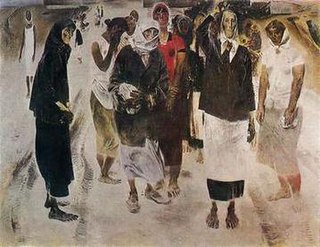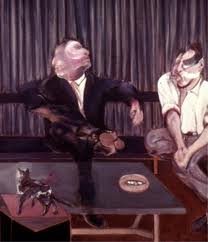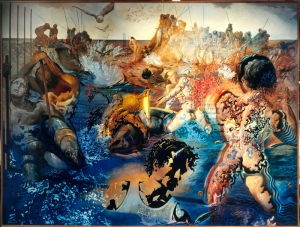 W
WCreated in 1967, the Stockholm Big Electric Chair is part of a series of works by Andy Warhol depicting an electric chair. Death by electrocution was a controversial subject in New York City, where the artist lived and worked, especially after the last two executions at Sing Sing Correctional Facility in 1963. Warhol obtained a photograph of the empty execution chamber, which became the basis for this series.
 W
WA Bigger Splash is a large pop art painting by British artist David Hockney. Measuring 242.5 centimetres (95.5 in) by 243.9 centimetres (96.0 in), it depicts a swimming pool beside a modern house, disturbed by a large splash of water created by an unseen figure who has apparently just jumped in from a diving board. It was painted in California between April and June 1967, when Hockney was teaching at the University of California, Berkeley. Jack Hazan's fictionalised 1973 biopic, A Bigger Splash, concentrating on the breakup of Hockney's relationship with Peter Schlesinger, was named after the painting.
 W
WChairman Mao en Route to Anyuan is a 1967 oil painting by Liu Chunhua. It pictures a young Mao Zedong as one of the common people, ready to take on any obstacle that comes forth. This artwork is a strong example of Chinese communist propaganda and shows the devotion which their culture had to Chairman Mao.
 W
WMothers, Sisters is a painting by Russian artist Yevsey Moiseyenko (1916–1988).
 W
WNude With Dressing Gown is a 1967 painting by Australian artist John Brack. The painting depicts a nude woman putting on a dressing gown. Unusually for a Brack nude, the painting is a not a formal sitting; instead the subject is "caught ... in a more private moment as she modestly dons a gown".If his subject was not glowing with an almost fluorescent, irradiated green, this would be one of Brack's most sensual pictures. His model is lithe, adorned with a fashionable 1960s-style bob. She is far from Rubenesque, but the twist of hip is distinctly feminine. ... But any sensuality is counterbalanced by Brack's garish colouration.
 W
WPortrait of George Dyer and Lucian Freud was a 1967 oil on canvas painting by the Irish-born artist Francis Bacon, which he destroyed before it left his studio, though it was photographed and is highly regarded by art critics. Bacon was a ruthless self critic, and often abandoned paintings mid-work, or slashed finished canvases; something he often later regretted.
 W
WPortrait of Isabel Rawsthorne Standing in a Street in Soho is a 1967 oil on canvas painting by the British figurative artist Francis Bacon, housed in the Alte Nationalgalerie, Berlin. Described by art critic John Russell as one of Bacon's finest works, it depicts Isabel Rawsthorne, the painter, designer and occasional model for artists such as André Derain, Alberto Giacometti and Picasso.
 W
WRussian Schoolroom (1967) — also known as The Russian Classroom and Russian Schoolchildren — is an oil on canvas painting created by American illustrator Norman Rockwell (1894–1978) and commissioned by Look magazine. It depicts Russian schoolchildren in a classroom with a bust of Soviet leader Vladimir Lenin.
 W
WSecret Painting, is a series of contemporary art works by Mel Ramsden created between 1967 and 1968. These contemporary art works all consist of a monochrome painting associated with a text panel.
 W
WTuna Fishing was painted by Salvador Dalí in 1966–1967 and is seen by many as one of Dalí's last masterpieces. Filled chaotically with the violent struggle of the men in the picture and the big fish. A golden knife stabs into the fish and the azure-blue sea becomes red with blood.
 W
WVoice of Fire is an acrylic on canvas abstract painting made by American painter Barnett Newman in 1967. It consists of three equally sized vertical stripes, with the outer two painted blue and the centre painted red. The work was created as a special commission for Expo 67. In 1987 it was loaned to the National Gallery of Canada in Ottawa, Ontario, Canada.
 W
WWho's Afraid of Red, Yellow and Blue is a series of four large-scale paintings by Barnett Newman painted between 1966 and 1970. Two of them have been the subject of vandalistic attacks in museums. The series' name was a reference to Who's Afraid of Virginia Woolf?, the 1962 play by Edward Albee, which was in itself a reference to "Who's Afraid of the Big Bad Wolf?", the 1933 song immortalized in Disney cartoons.